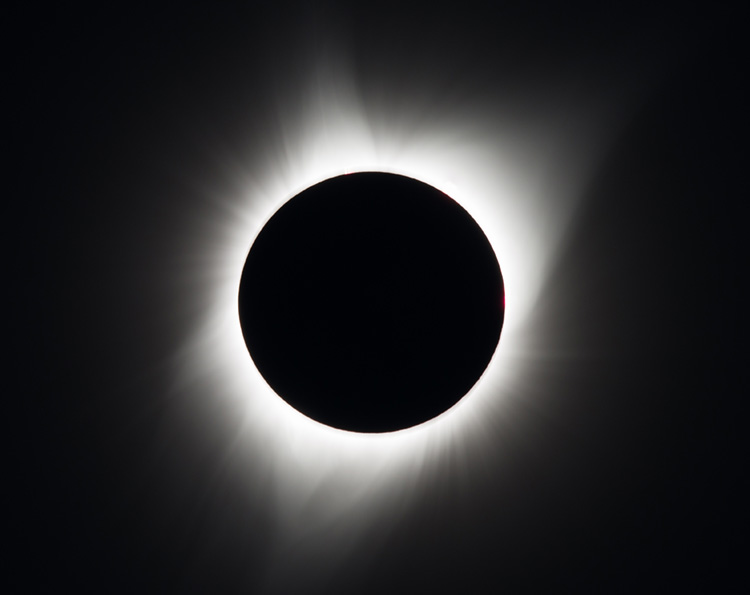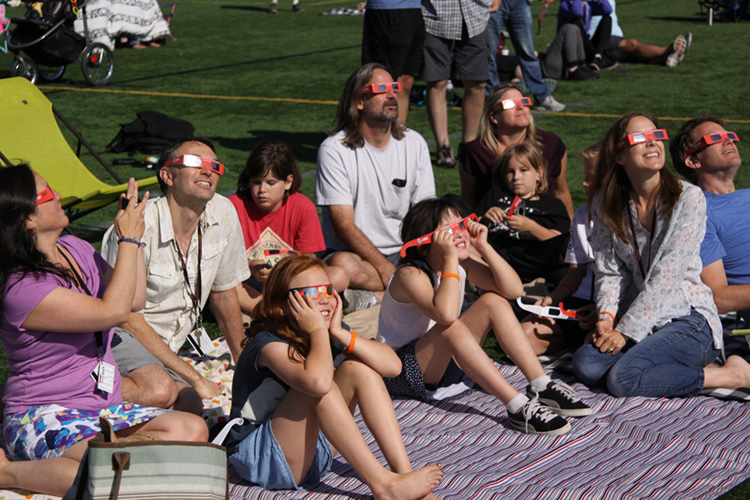This photograph, taken from Northern Cascades National Park in Washington, shows the moon passing before the sun during the solar eclipse of Aug. 21, 2017. Credit: Bill Ingalls, NASA
Yesterday, on August 21, huge crowds gathered across the United Statesto watch the solar eclipse within the path of totality, the 70-mile (113-kilometer) wide swath of land from Oregon to South Carolina where the moon completely covered the sun. In Newport, Oregon, throngs of sky watchers greeted the eclipse as it made first landfall at 10:15 a.m. local time. Many thousands of eclipse chasers filled the totality town of Carbondale, Illinois (where the eclipse was longest). Local merchants greeted the tourists with special jewelry, cookies, doughnuts, and other eclipse-themed goods. Across the country, roads toward the path of totality were jammed with traffic and hotels were booked solid—sometimes a year or more in advance of the big event.
A total solar eclipse can have a powerful psychological effect on people. Many people, especially in large urban areas, don’t often have reason to look toward the sky in the middle of the day. But, as the moon begins to move over the sun, people could not help but notice the odd darkening of the sky unlike anything they had ever seen. Many people reported feeling a profound sense of awe and a spiritual connection with other people. Others reported a tremendous feeling of unease as the sunlight dimmed and gradually faded completely. But, unlike the experience in ancient times, there were no reports of panic among the masses of eclipse watchers. Astronomers have long been able to precisely predict the time and place of such celestial events. Yesterday, people cheered and applauded the eclipse as they might ooh and aah at a fireworks show, and eclipse glasses (with lenses dark enough to safely view the sun) were passed from hand to hand.

The moon totally blocks the sun during the solar eclipse of Aug. 21, 2017, above Madras, Oregon. Only the sun’s corona is visible around the moon. Credit: Aubrey Gemignani, NASA
At peak totality, the bright disk of the sun was replaced by a dark spot, surrounded by a blazing ring–the sun’s outer atmosphere (called the corona) that is easily visible only during an eclipse. In some regions, people felt a noticeable temperature drop as day briefly turned to night. Stars and planets became visible in the midday sky. Crickets began chirping, thinking night had begun a bit early, and birds roosted and went silent. Some eclipse chasers were surprised and annoyed by mosquitoes, which were fooled into thinking dusk had arrived and went hunting a few hours early.

People gaze skyward wearing eclipse glasses during the solar eclipse of Aug. 21, 2017, on the Oregon State University campus in Corvallis, Oregon. Credit: Mark Floyd, Oregon State University (licensed under CC BY-SA 2.0)
The great solar eclipse of 2017 left the United States just north of Charlotte, South Carolina, at 4:10 p.m. local time. Peak totality ended at 2:49 p.m. at that location. Anyone who missed the eclipse this year will not have to wait long for another chance. The next total solar eclipse visible from a large portion of the United States will occur on April 8, 2024. And Carbondale, Illinois, will once more have a chance to shine. It is the only city that will be in the path of totality in both 2017 and 2024. It’s not too early to start planning!
Untitled Document Can't view the linked articles? Subscribe to World Book Online

World Book Online delivers a progressive sequence of core databases supported by supplemental
tools, such as language translation, graphic organizers, and unique Webquests. Moving from
Early World of Learning to World Book Advanced, World Book Online aligns end-users with their
appropriate learning levels. Each stand-alone site provides additional features to support the
needs of users’ specific capabilities.
The World Book Difference
World Book combines cutting-edge technology with traditional editorial excellence to produce
authoritative, trustworthy, and unbiased content. The digital content is updated in real time and
carefully curated for each learning level. Accessible 24/7, the content is available on a variety of devices.
World Book Online combines 21st-century instructional techniques with timely information.
By breaking down complex topics and using easily understandable text, World Book Online helps to
build fluency and increase comprehension. Featuring single sign-on capability, these sites are paired
with highly visual content to engage even the most reluctant reader. Our collection of resources kindles
a lifelong learning experience for every user. This adherence to clarity, currency, and accuracy makes
World Book’s digital offerings an information hub for the classroom, library, and beyond.
|